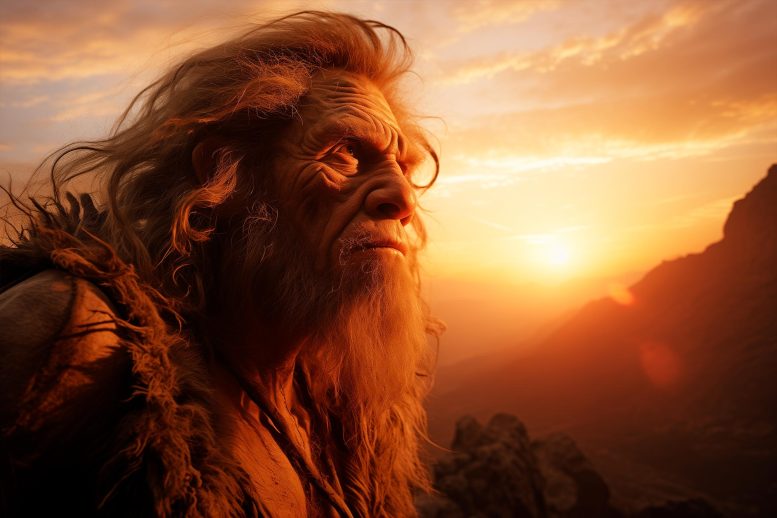
A recent study challenges previous claims that Homo naledi, a species dating back to between 335-241,000 years ago, deliberately buried their dead and created rock art in Rising Star Cave, South Africa. Experts in various fields argue that the evidence is not strong enough to support these assertions, citing a need for more rigorous scientific analysis and documentation.
Recent research challenges the assertions that Homo naledi, an ancient human relative with a smaller brain dating back to 335-241,000 years ago, intentionally buried their deceased and created rock art in Rising Star Cave, South Africa.
Three pre-print articles published in 2023 in eLife suggested the recent excavations at the Rising Star Cave system provided evidence of at least three burial features, two in the Dinaledi Chamber and a third in the Hill Antechamber cavity.
The articles claimed the features represented the earliest evidence of deliberate burial by a hominin species, and that Homo naledi lit up dark passageways using fire and intentionally carried the bodies of at least three individuals deep inside the Rising Star Cave system, dug pits, deposited corpses inside the pits, and covered the bodies with sediments.
It was also claimed that the Hill Antechamber feature contained a stone tool in close proximity to the hominin hand.
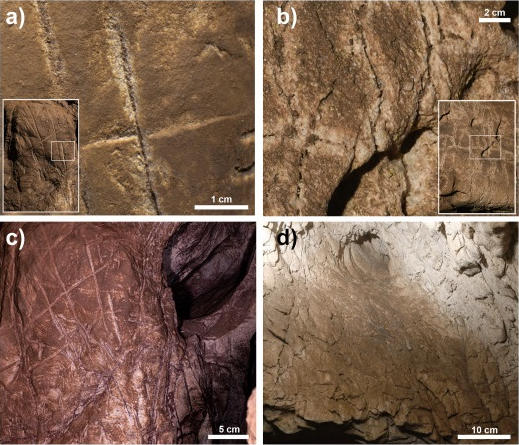
Detail of the dissolution processes in the fissures, interpreted as engravings by Berger et al. (2023b), but clearly natural in other cases. Credit: Elsevier
Scholarly Critique and Analysis
However, a group of renowned experts with specializations in biological anthropology, archaeology, geochronology, and rock art, have now called for a deeper dig into the science behind the findings in a first, peer-reviewed critique published in the Journal of Human Evolution (JHE).
Professor Michael Petraglia from Griffith University’s Australian Research Centre for Human Evolution, Professor Andy Herries from La Trobe University, María Martinón-Torres from the National Research Center on Human Evolution in Spain, and Diego Garate from the University of Cantabria in Spain co-authored the peer-reviewed article.
Reevaluation of the Evidence
The research team concluded the evidence presented so far was not compelling enough to support the deliberate burial of the dead by Homo naledi, nor that they made the purported engravings.
“We really need substantial additional documentation and scientific analyses before we can rule out that natural agents and post-depositional processes were responsible for the accumulation of bodies/body parts and to prove the intentional excavation and filling of pits by Homo naledi,” Professor Martinón-Torres said.
Moreover, Professor Petraglia added: “Unfortunately, there is a distinct possibility that the so-called stone artifact next to the hominin hand is a geofact, and not a product of stone tool flaking by Homo naledi.”
Professor Herries said: “There is no evidence that Homo naledi lit fires in the cave, purported burying locations could just be from manganese staining and charcoal within the cave remains to be dated. Charcoal from natural fires is not uncommon in caves.”
“Detailed analyses are also needed to demonstrate that the so-called ‘engravings’ are indeed human-made marks, as marks like these can be produced as a product of natural weathering or animal claws,” said Dr. Garate.
The JHE commentary also offers a brief insight on the state of the field regarding the importance of responsible social communication and the challenges brought by new models of scientific publication.
Reference: “No scientific evidence that Homo naledi buried their dead and produced rock art” by María Martinón-Torres, Diego Garate, Andy I.R. Herries and Michael D. Petraglia, 10 November 2023, Journal of Human Evolution.
DOI: 10.1016/j.jhevol.2023.103464



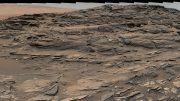
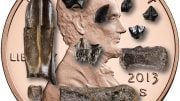
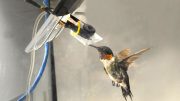

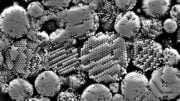

I’m just a lay person who grew up talking to archaeologist because my dad was a geologist who built museums. But all I just heard was haters say “Nu uh! You’re wrong! I can’t prove it now. But I will. I wish I’d found that. Jerk.”
Exactly what I was thinking.
Exactly!! Want to look at the “natural” or “animal claw” perfect “+” and perfect “box”? Nature does not produce perfect “+” or “box” shapes. And I would not like to meet the clawed animal capable of making them. Legitimate question. Have any of the 4 scientists who co-wrote this paper been to the site themselves? Just curious.
What further evidence is needed besides obvious graves, fire(there is charcoal) and the skeletons themselves? If this were a forensic crime scene, what other possibilities would exist? Bones randomly fell into a hole and buried themselves? Random and spontaneous combustion causing evident charcoal? Why is this so mind blowing for any scientists? They are the ones that are supposed to have an open opinion on past possibilities. This really makes me doubt current scientific opinions
Perhaps the skeletons could have been deposited deep in the cave structure by a large snake (constrictor) which are known to seek sheltered areas to digest large meals and, at times, regurgitate those meals if too large.
The large constrictors of that time period would have been able to navigate deep into the cave and down the shaft and, after regurgitation would have left the chamber to go hunt again.
We see current day occurrences of large constrictor snake swallow humans, so this type of behavior well may have happened in that time period.
Not arguing with this idea at all, I am not a snake person (see snake = run away) just a question. If the chamber was as inaccessible then as it is now, could the snake have made it with the massive lump of meat inside it? If it wasn’t as inaccessible, why keep bringing food that they cannot digest back to the same area multiple times?
How do we unlearn the biases that are piled high and deep through scholarship of the western mind that has excluded and oppressed those “Others” that were encountered? These biases seem to have turned off mirror neurons so they could only project the negative the “savage” of humanity onto others and not become consciously aware of the savage in themselves when Indigenous people for the most part had cultural ways and means to mitigat those tendencies to survive and thrive through ritualized insight into their proclivities as revealed in the Ha mass aa dances of the Kwak walk wa la clearly publicly and overtly depicting the high road of community norms and morality
Science still has a lot to learn and unlearn knowing one’s biases becomes critical to account for in project analysis or there are merely projectio gas on the walls of a cave!
I am positive you meant well. However, as a mere peasant, the word salad you left doesn’t actually say much. “Indigenous people are/were extremely intelligent and inventive. Markings were clearly not natural and painfully obviously not made by a clawed animal.”
Kind of sounds as if you just got a new dictionary and couldn’t wait to use the biggest words you could find. Seriously, no offense intended, however please put the dictionary down and write as if other humans might accidentally read this. 🙂 Thank you for your time.
Time to reflect on the historical savages of peoples’ origins and come to terms with one’s own Aboriginalit/indigeneity and own ourselves as humans
Better, but see above.
My oh my, how these comments reveal the high degree of credibility in so many people. They likely saw the dramatic doc “Cave of Bones” non-critically and became convinced those likeable people would not deceive us or that they might leap to over-enthusiastic conclusions. There is so much about the context of these findings that throws those conclusions into doubt.
Conscious bias against women being anything other than mothers and gatherers of leaves nuts and fruit has held archeology back for years / that absurd notion that people that moved seasonally didnt plant crops or sprinkle the ground with seeds of the plants they favoured that farming began with men and ploughs has bocked the minds of archeologists/ consrantly calling every circle or stones an offering to the gods, every carving of a female shape a goddess and not for a moment considering carvings could be created as gifts or in learning improving skills – come on there is so much more i could say. Sometimes i just want to shake you lot up and open you minds
I am a woman, in every way you would describe it (i.e. born biological female, present as female, husband, 3 kids etc etc etc…).
What in that article made you think for a second they were saying the conclusions were wrong because the archeologists were smallish women?? Leave your bias here please. The science isn’t wrong because of your bias, it’s just wrong. Period. You making it about gender just makes “them” sound more credible. Oh, and at least one of the four co-authors was female.
It’s hardly a new study, it was published last November. I wish it wasn’t behind a paywall – I’m interested but not quite enough to pay $28 to read it. The evidence for fire and the possible engravings are debatable, but I find it very hard to see how so many Homo naledi bones could have accidentally made their way into such inaccessible places, but the only animal bones were a few owl and rodent bones on the surface. Hominin bones are usually greatly outnumbered by other animal bones, but here this is reversed. That’s hard to explain.
Very elegantly said sir. I thank you.
You should read the book “Cave of Bones”, by the world class paleontologists who did the dig. No doubt the Naledi interred the bodies and did the simple carvings. Cave site is almost completely inaccessible and not subject to drainage, carnivore dens, or other explanations. Bodies were in stratigraphically interrupted depressions and covered. In other words, buried.